Gongura Pachadi Recipe (Sorrel Leaves Chutney)
Gongura Pachadi is a tangy, spicy and flavorful chutney from Andhra cuisine, prepared using sorrel leaves, locally called ‘gongura (Hibiscus sabdariffa).’ The red-stemmed variety is often preferred for its pronounced sourness, though the green-stemmed one is also traditional, offering a milder tang and softer texture. The jagged leaves are sautéed in oil and blended with tempered spices to create a bold, earthy chutney that tastes delicious with hot steamed rice, especially when topped with a touch of sesame oil or ghee.
Andhra Gongura Pachadi Recipe
In Andhra cuisine, ‘gongura’ refers to sorrel leaves, scientifically known as Hibiscus sabdariffa. Two main varieties are commonly used:
- Red-stemmed gongura: Features darker green leaves with reddish stems and a pronounced sourness, often favored in traditional recipes.
- Green-stemmed gongura: Lighter in color, more tender and slightly less tangy, yet just as traditional and widely used, especially when red-stemmed is not available.
What I’m sharing here is a Gongura Nilava Pachadi – a simple, bold-flavored version made with Sorrel (Hibiscus sabdariffa) called Gongura in Telugu language.
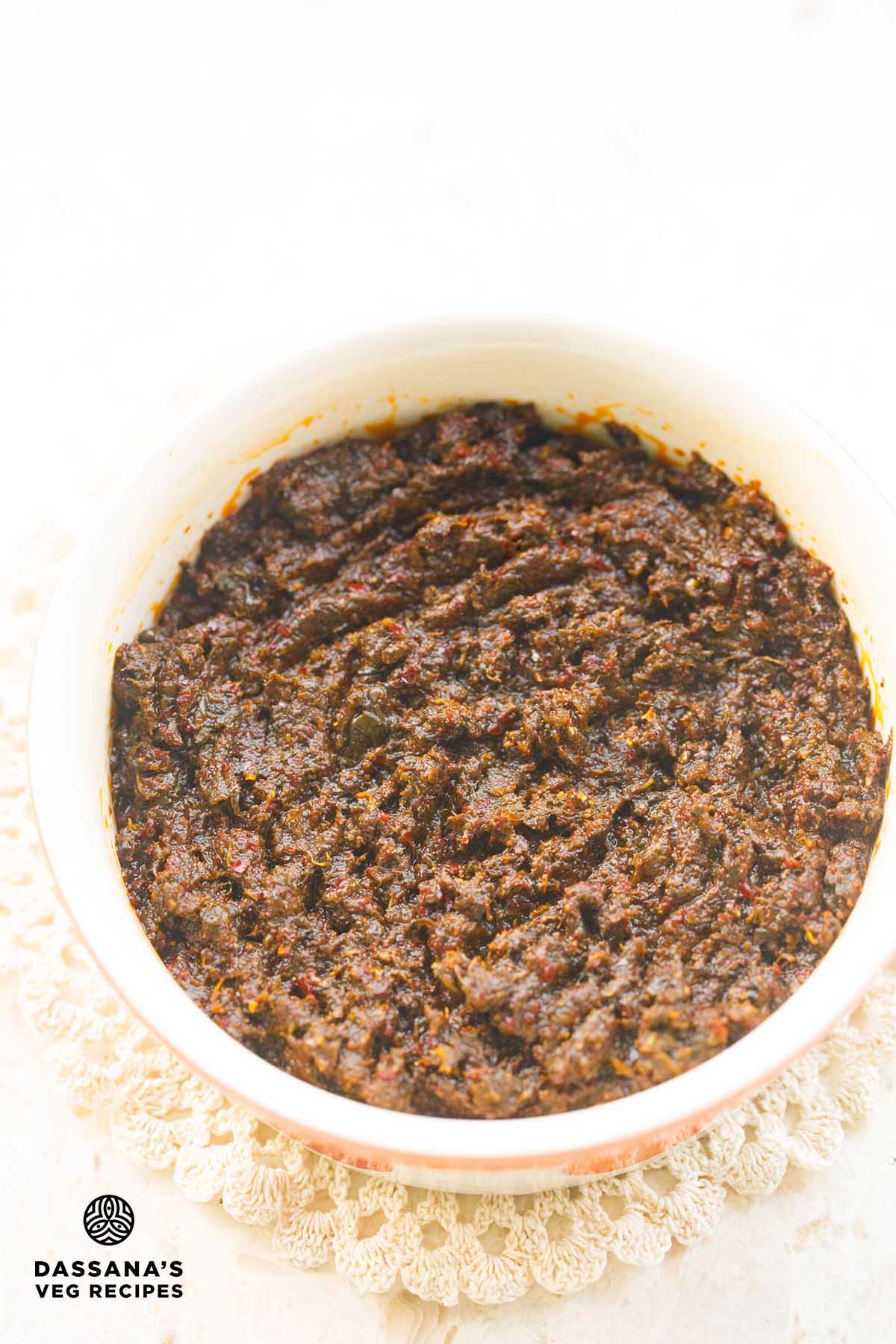
Table of Contents
Additionally, the word ’Nilava’ in Telugu means something that is preserved or stored for a longer time. The term ’Pachadi’ is a traditional South Indian word for a spicy, tangy chutney or pickle.
A classic from Andhra and Telangana, this Sorrel Chutney is known for its punchy taste and long shelf life. It has a tangy, spicy flavor that pairs perfectly with hot rice and a spoonful of ghee or sesame oil.
In fact gongura is a staple in Andhra households and finds its way into chutneys (pachadi), dals and pickles.
The Gongura Pachadi, in particular, is known for its bold, robust complex flavors with subtle bitter undertones. While some call it a chutney and others a pickle, there are many ways to prepare this awesome dish.
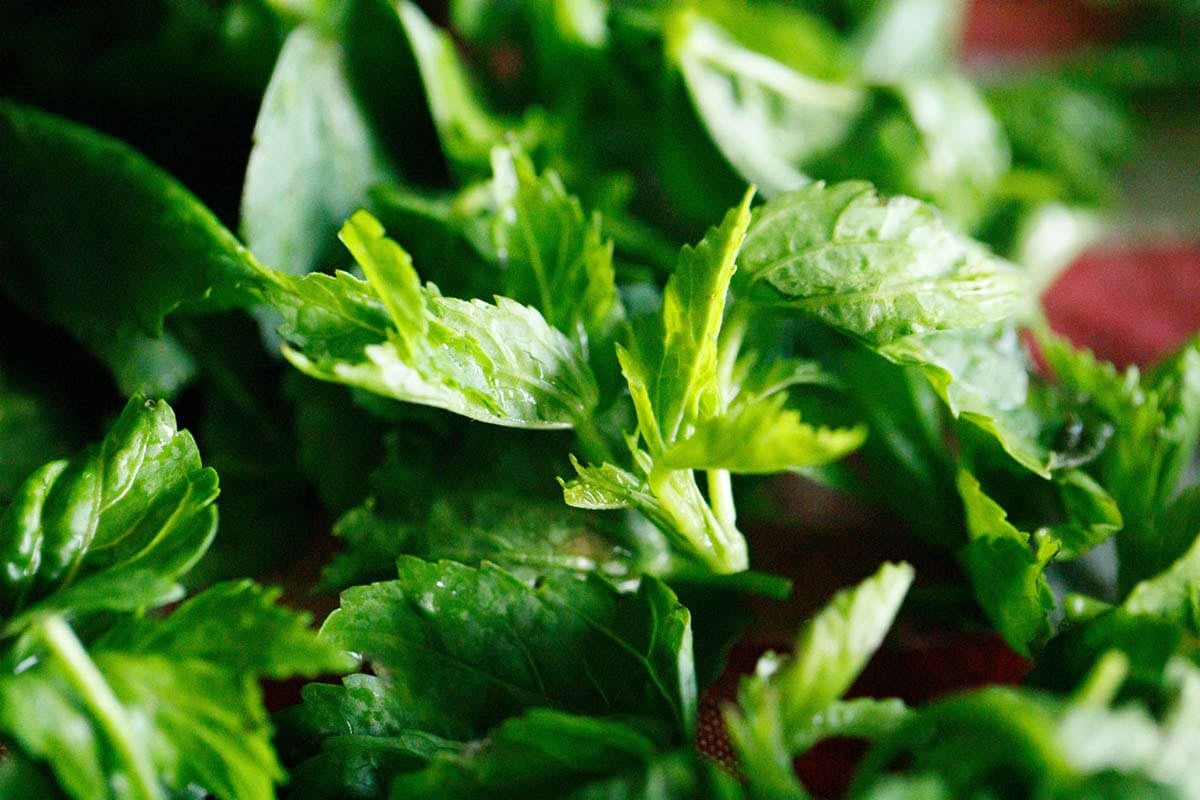
In my recipe, I’ve used green-stemmed gongura leaves, but it works just as well with red-stemmed leaves. Feel free to use whichever variety is available to you. The red variety gives a sharper tang, while the green brings a milder flavor.
My version also uses minimal oil, making it a lighter option that still keeps well for a few weeks. If you plan to make a larger batch or store the Gongura Pachadi longer, you can increase the oil quantity to help preserve it.
Some More Pachadi Varieties To Try
- Cabbage Pachadi
- Beetroot Pachadi
- Allam Pachadi (Andhra Style Ginger Chutney)
- Ugadi Pachadi
- Pudina Pachadi
How to make Gongura Pachadi
Prep & Sauté Sorrel Leaves
1. Pluck leaves from stems. You should get 6 cups of gongura leaves. Rinse the leaves very well in water to remove any dirt or grit. Drain extra water from the rinsed leaves and dry the leaves.
Spread them on a clean cloth for drying. Do not dry in sunlight. Dry in shade or in your kitchen. Drying takes a few hours.
It is important to dry leaves so that any extra water does not come into the pachadi. This will spoil it further. The leaves should not be wet or moist.
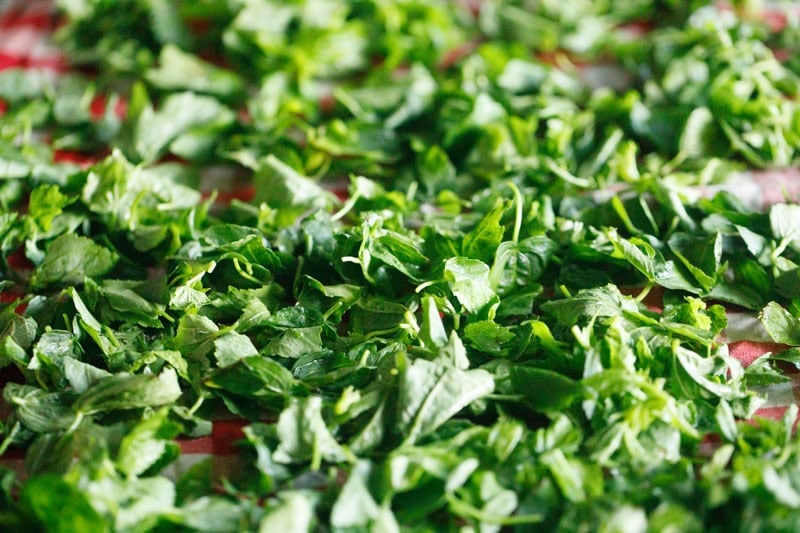
2. Heat ¼ cup oil in a kadai or sauté pan. Add the 6 cups of gongura leaves.
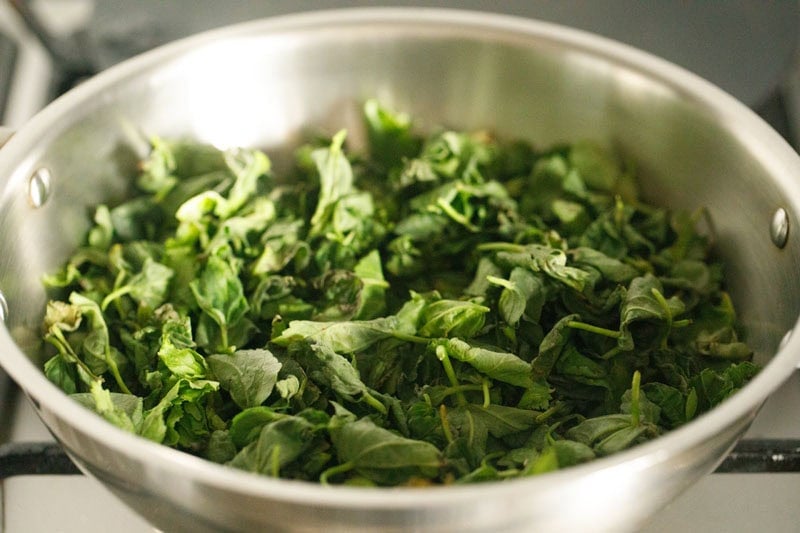
3. Mix and begin to sauté, stirring often.
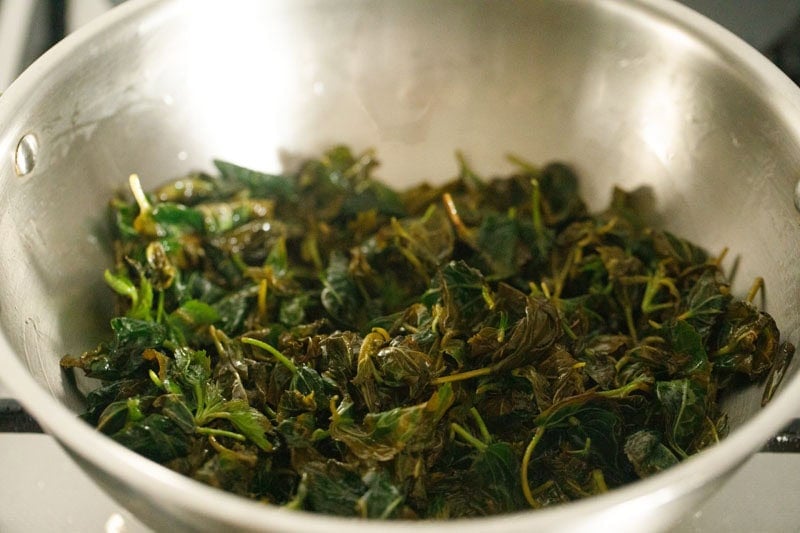
4. First, the leaves will wilt. Continue to sauté until oil separates at the sides. The cooking time for the leaves will range from 10 to 12 minutes on a low to medium-low heat.
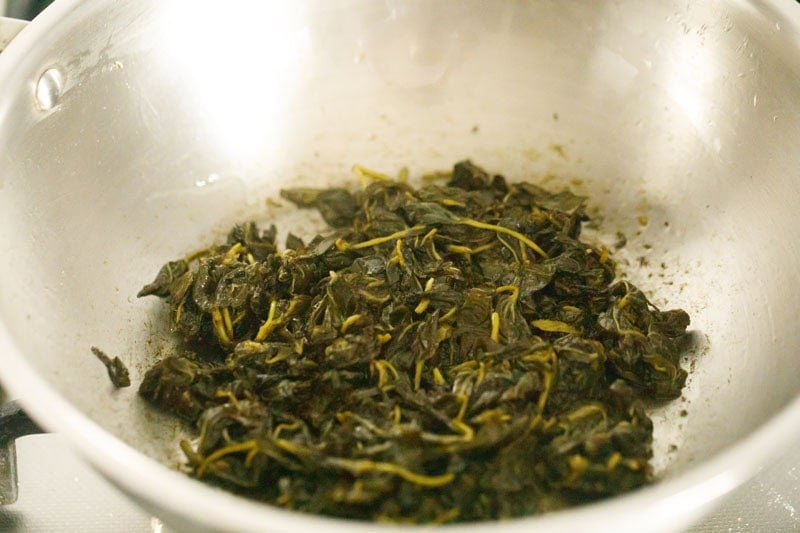
5. Set the sautéed leaves aside on a plate to cool.
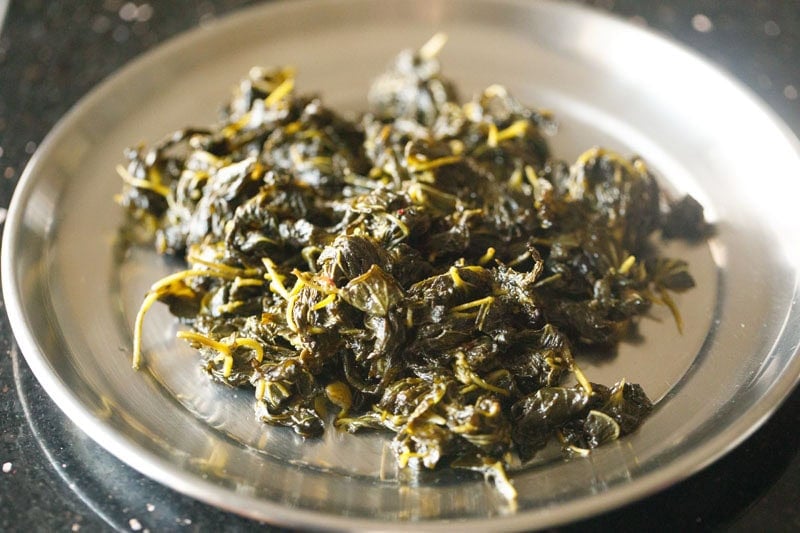
Temper Spices
6. Heat 2 tablespoons oil in another pan or same pan.
Add 1 teaspoon mustard seeds. When they crackle, turn off the heat.
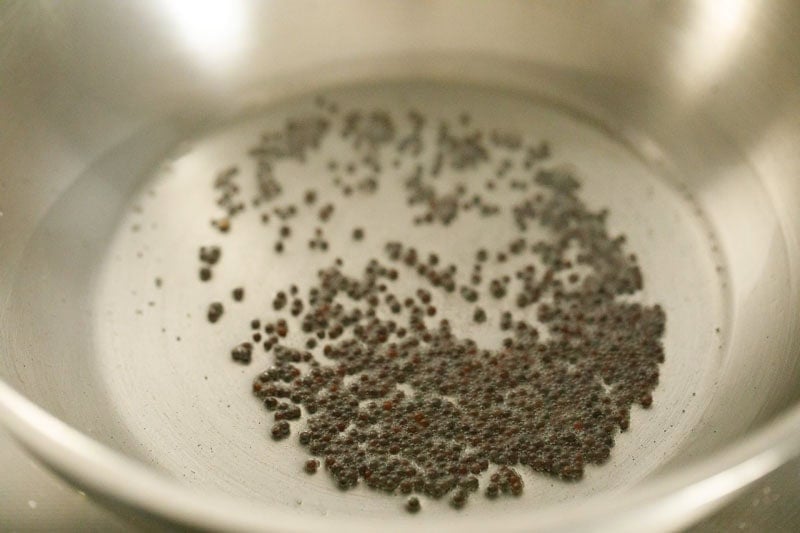
7. Add ½ teaspoon fenugreek seeds and ½ teaspoon asafoetida. Stir to mix and let the fenugreek seeds change color.
Ensure that the seeds are fried well and do not burn or get browned too much.
Note: If the fenugreek seed remain raw or are browned too much or get burnt, then they taste bitter.
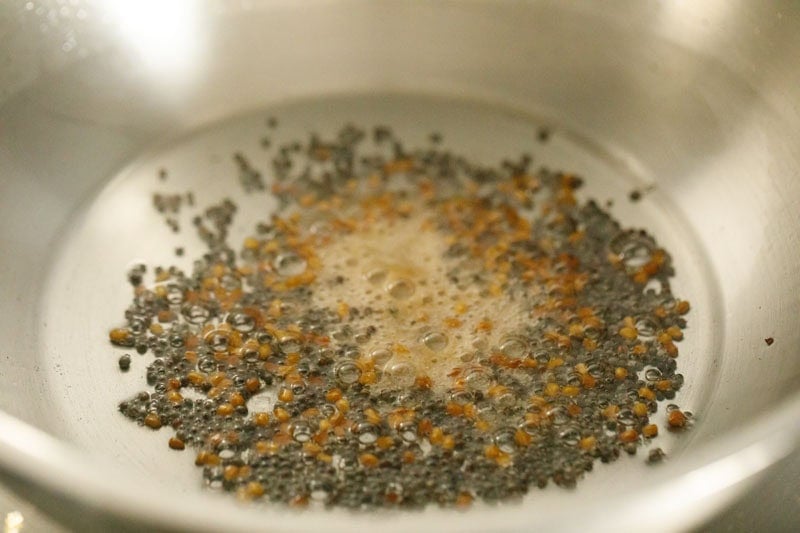
8. Add 7 to 8 medium-sized Kashmiri dried red chilies (I used 5 large-sized) and 2 sprigs curry leaves (or 30 small curry leaves), and mix.
Tip: Halve or break and remove seeds from the red chillies before using them.
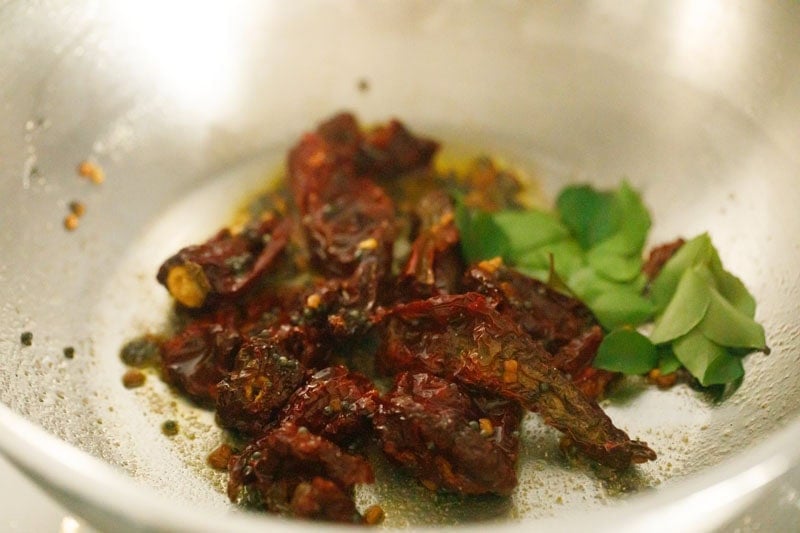
9. Turn on the heat and keep it to a low. Stir often, until red chilies change color and look crisp.
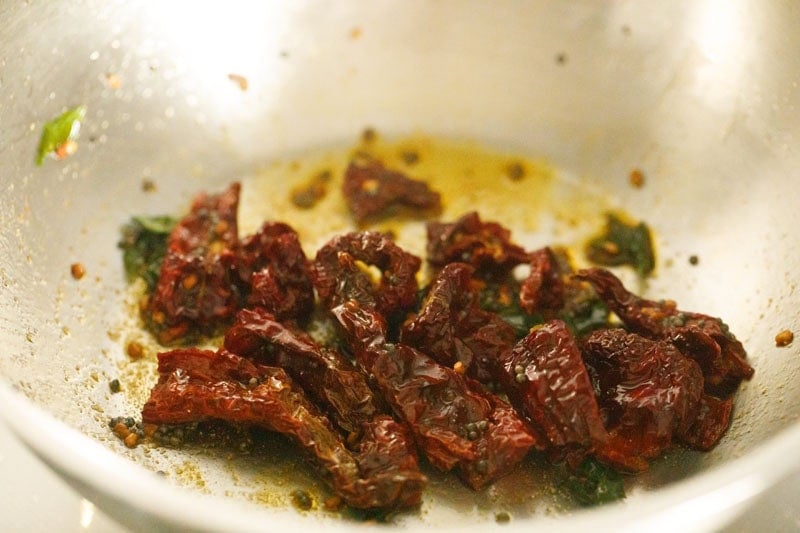
10. Turn off the heat again. Add ¼ teaspoon turmeric powder and mix.
Set aside this tempered spices mixture to cool on a separate plate.
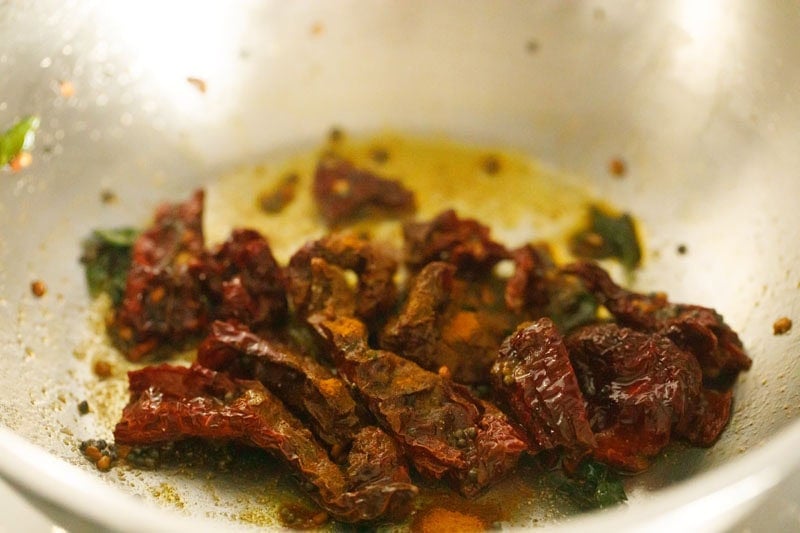
Make Gongura Pachadi
11. Transfer to a mixer-grinder. Add ½ teaspoon pink salt or regular salt according to taste.
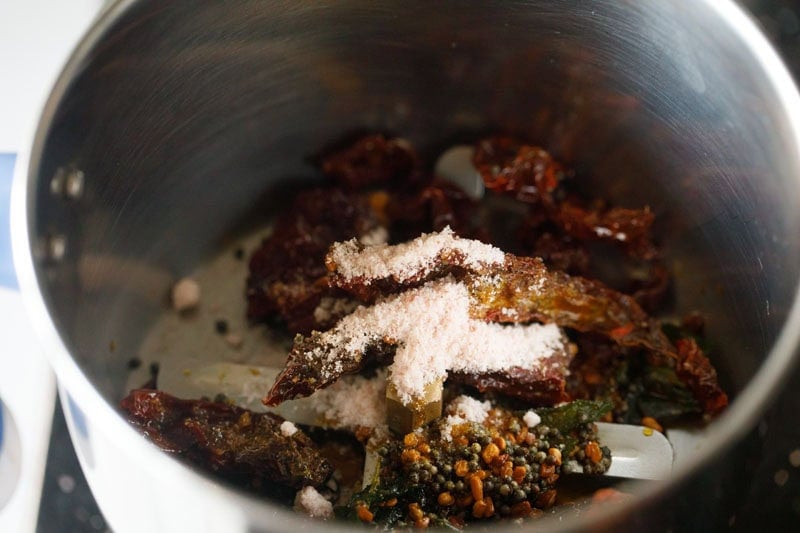
12. Grind to a coarse mixture.
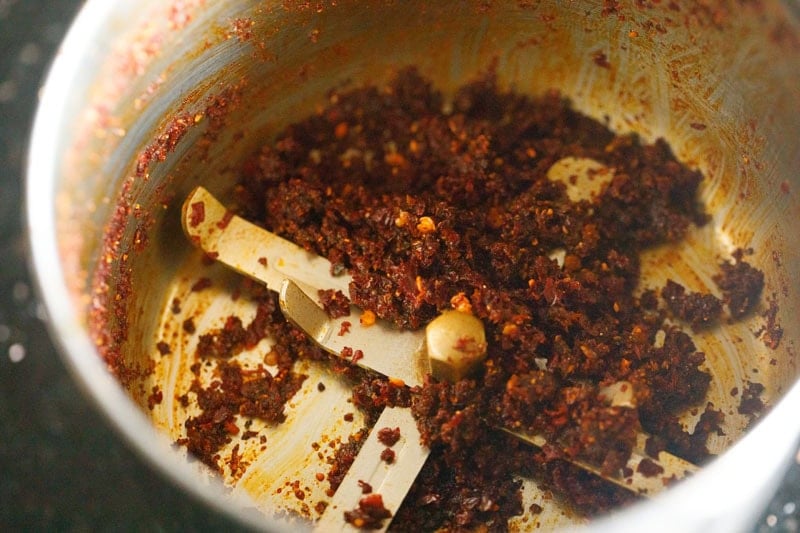
13. Add the sautéed gongura leaves together with any extra oil that has remained after sautéing them.
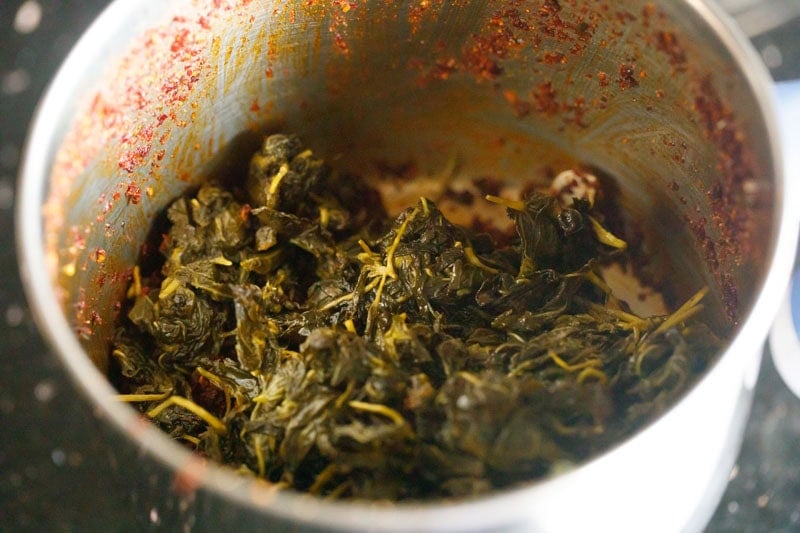
14. Pulse or grind in small bursts to a coarse or semi-coarse texture.
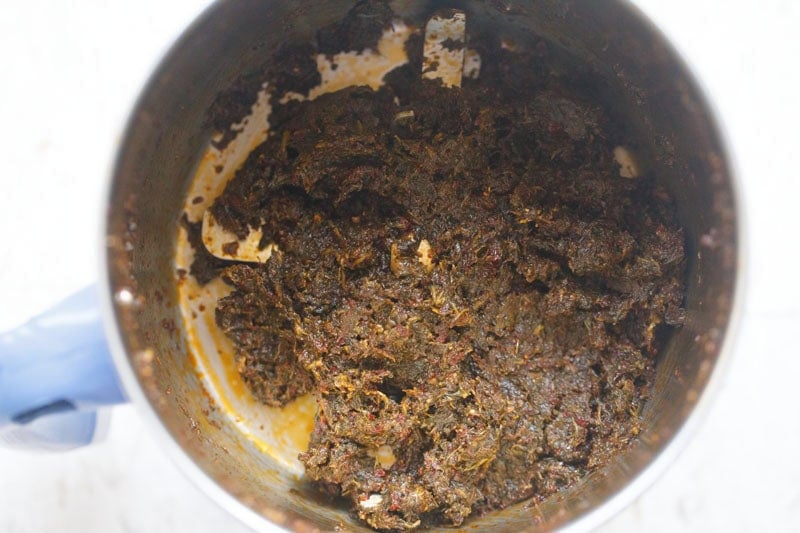
15. Transfer Gongura Pachadi to a clean bowl or jar. Keep it air-tight and sealed with a lid.
Tip: Avoid storing in metal containers or bowls, as the sourness of gongura may react with them.
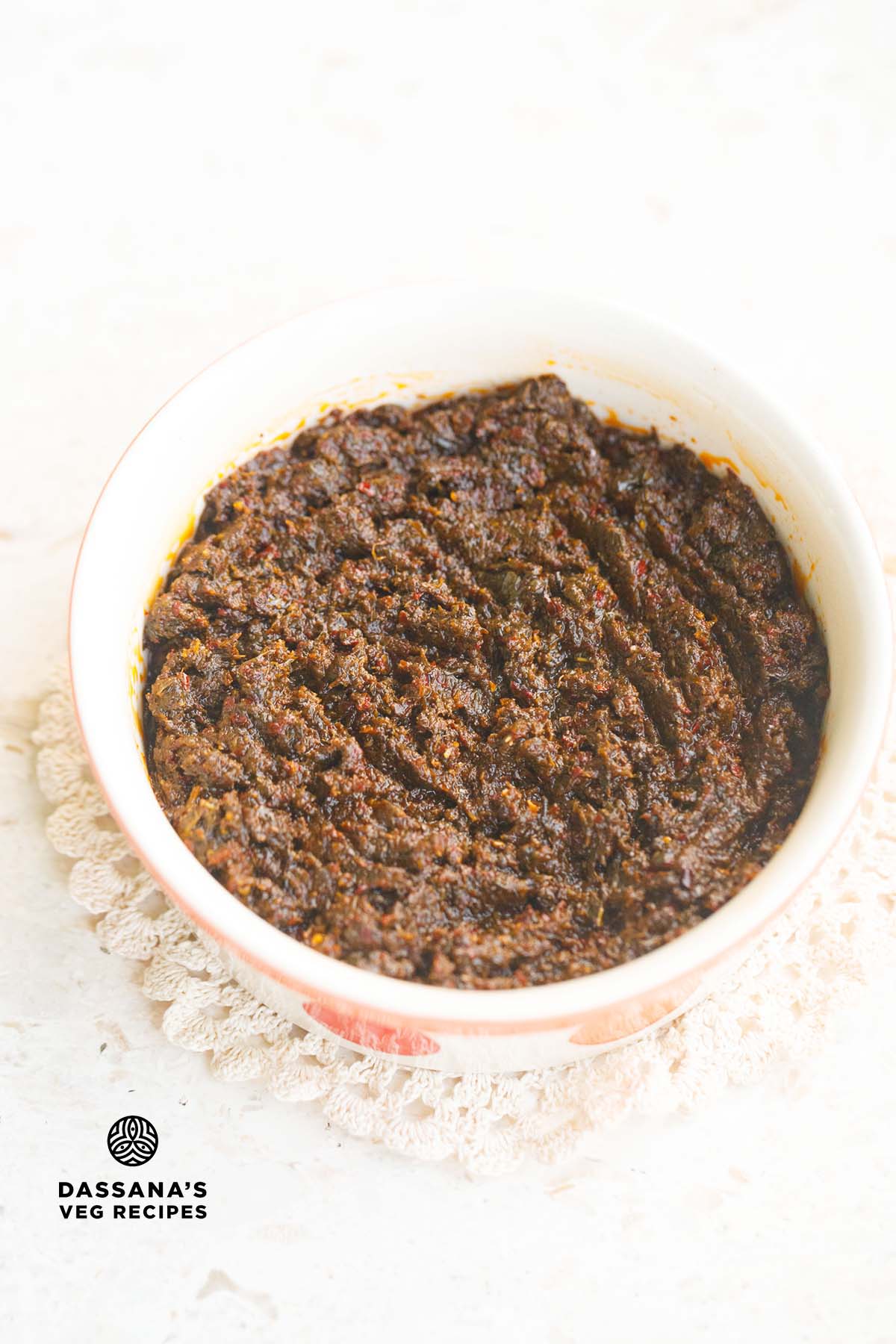
Storage & Serving Suggestions
Refrigerate the bowl or jar with the pachadi and use it as needed. When removing the pachadi, use a clean dry spoon. Gongura Pachadi keeps well for about a few weeks when refrigerated.
If you want to store for a longer period of time, freeze the chutney in small portions. Thaw it before using.
Gongura Pachadi is best enjoyed as a side dish or mixed into hot steamed rice. It also pairs well with chapati.
You can serve Gongura Pachadi alongside South Indian meals like Sambar, dal or Rasam with rice. It’s equally delicious when accompanied by Curd Rice for a tangy-spicy contrast.
Expert Tips
- Tempering options: For extra flavor, in a bit of oil, temper mustard seeds, curry leaves and a pinch of asafoetida (hing) and add this tempering to the prepared chutney.
- Add crunch with lentils: You could include urad dal or chana dal in the tempering for a subtle crunch and nuttiness.
- Adjust chilli for heat: Customize the spice level by increasing or decreasing the number of red chilies based on their pungency and heat.
- Use of Kashmiri chilies: Kashmiri red chilies offer vibrant color with milder heat. Use 5 to 6 medium-sized chillies, if you prefer a less spicy chutney. You could also include a few green chillies, if you like.
- Balance bitter & tangy notes: To mellow the bitterness of fenugreek seeds and tartness of sorrel, keep the fenugreek seeds to just ¼ teaspoon if using fewer chillies.
- Including tamarind: Opt to add a small piece of tamarind, for a more pronounced sour taste or if the gongura leaves are less our.
- Richer flavor with garlic: For added depth while serving, fry some garlic and stir it into the chutney.
- Oil adjustment: Add more oil if you prefer a richer, more pickle-like consistency.
- Optional ingredients: Curry leaves and turmeric can be skipped if desired – they’re optional additions.
FAQs
What does sorrel leaves taste like?
Sorrel leaves have a distinct tangy and sour taste, with earthy and mildly bitter undertones. These complex flavors makes it a standout ingredient in chutneys like the Gongura Pachadi, pickles and curries.
What is gongura famous for?
Gongura is best known for its use in Andhra cuisine, especially in the iconic dish Gongura Pachadi. It’s also popular in pickles and lends a unique sourness to dals and curries in South Indian cooking.
How many types of sorrel are there?
There are mainly 2 types of sorrel or gongura commonly used in cooking:
– Red-stemmed gongura: more sour and preferred in traditional recipes
– Green-stemmed gongura: milder in tang and tender in texture
What is the other name of gongura?
Gongura is botanically known as Hibiscus sabdariffa and is also referred to as sorrel leaves in English. In different Indian languages, it’s known by names like ‘pulicha keerai,’ ’ambadi’, ’pundi soppu’, or ‘pitwaa’.
Step by Step Photo Guide Above
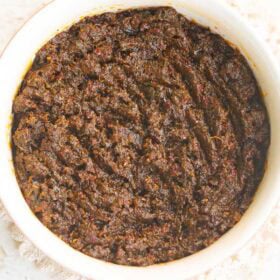
Gongura Pachadi Recipe (Andhra Style)
Ingredients
Main Ingredients
- ¼ cup oil – sesame oil, sunflower oil or peanut oil
- 6 cups gongura leaves – green stemmed or red stemmed sorrel leaves
- ½ teaspoon pink salt or edible rock salt, add regular salt according to taste
For Tempering
- 2 tablespoons oil – sesame oil, sunflower oil or peanut oil
- 1 teaspoon mustard seeds
- ½ teaspoon fenugreek seeds
- ½ teaspoon asafoetida
- 7 to 8 Kashmiri chillies – medium-sized, I used 5 large sized kashmir red chilies
- 2 sprigs curry leaves or 30 small curry leaves, optional
- ¼ teaspoon turmeric powder
Instructions
Prep Sorrel Leaves
- Pluck the gongura leaves from their stems. Rinse thoroughly in water to remove any dirt or grit.
- Spread the rinsed leaves on a clean kitchen cloth to air-dry. Do not sun-dry; instead, dry them in the shade or indoors in your kitchen.Note that drying the leaves takes a few hours.
- Ensure the leaves are completely dry. Any residual moisture can spoil the pachadi.
Sauté Ingredients
- Heat ¼ cup oil in a pan.
- Add the dried gongura leaves and sauté. The leaves will first wilt, then slowly release moisture.
- Continue sautéing until the oil starts to separate and leaves are well-cooked.The cooking time for the leaves will vary from 10 to 12 minutes on a low to medium-low heat.
- Set aside and let the sautéed leaves cool.
Temper Spices
- Heat 2 tablespoons oil in the same pan or in another pan.
- Add mustard seeds. When they begin to crackle, turn off the heat.
- Add fenugreek seeds and asafoetida. Mix gently and let the fenugreek change color slightly.
- Add dry red chillies and curry leaves. Turn the heat back on to low and sauté, stirring often, until the chillies turn crisp and changer color to a slightly darker red.
- Turn off the heat. Add turmeric powder and mix. Let this tempering cool completely.
Make Gongura Pachadi
- Transfer the cooled tempering mixture to a mixer-grinder. Grind to a coarse powder.
- Add the sautéed gongura leaves along with any oil remaining in the pan. Add salt.
- Pulse or grind in short bursts until you get a coarse or semi-coarse texture.
- Transfer to a clean, dry glass jar or a ceramic bowl.
Storage
- Refrigerate the pachadi in air-tight glass or ceramic bowl or jar and use as needed.
- Always use a clean, dry spoon when serving to maintain shelf life. It keeps well for about a few weeks when refrigerated.
Serving Suggestions
- Serve Gongura Pachadi with hot steamed rice with a light drizzle of ghee or sesame oil.
- The spicy and sour flavors of Gongura Chutney also pairs well with curd rice or sambar, rasam and plain dal with steamed rice.
- It can also be enjoyed as a side with idli, dosa, or chapati.
Notes
- Red Chillies: Adjust the dried red chillies based on their heat. I used Kashmiri chillies for mild heat and color. Use 5 to 6 medium-sized Kashmiri chillies for less spice or more for a spicier pickle. But note that the spiciness and the heat from the chillies, balances the tartness of gongura and the bitterness of fenugreek. Hence reduce fenugreek to ¼ teaspoon if using fewer chillies.
- Optional Ingredients: Curry leaves and turmeric are optional.
- Including Garlic: For extra flavor, fry garlic and mix with the pachadi before serving.
- Second Tempering (Optional): For added flavor, mustard seeds, curry leaves, hing, urad dal, or chana dal can be fried in a bit of oil and mixed into the prepared pachadi.
- Oil: Add more oil if desired, especially for longer shelf life. You can use sesame oil (gingelly oil) for authentic flavor, or substitute with sunflower or peanut oil – both work well in this recipe.



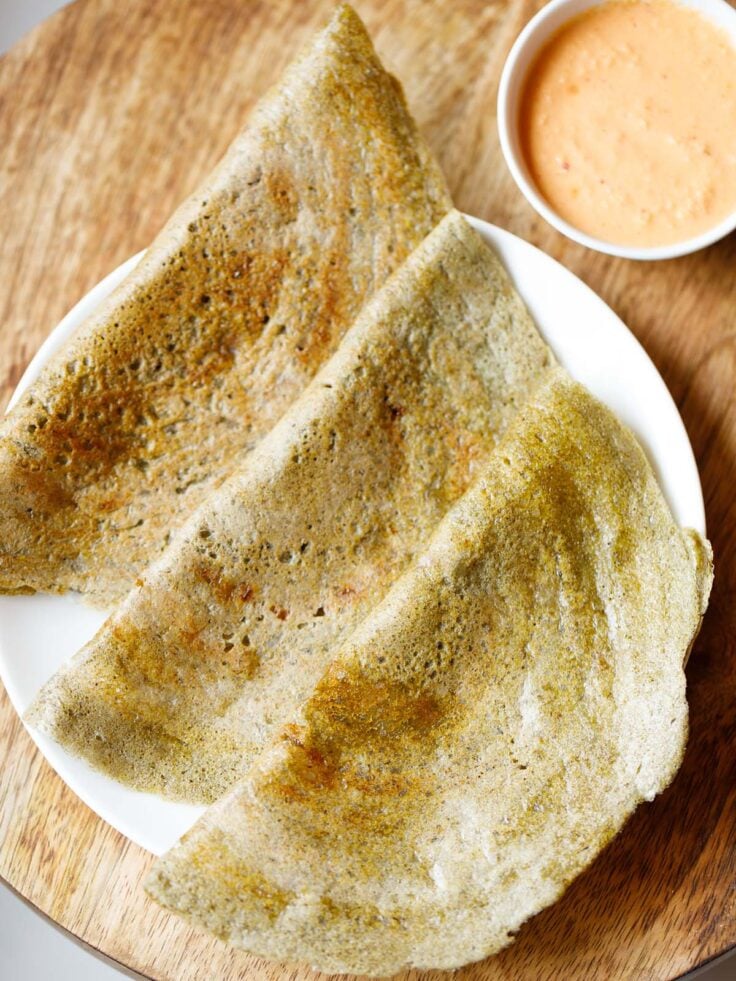
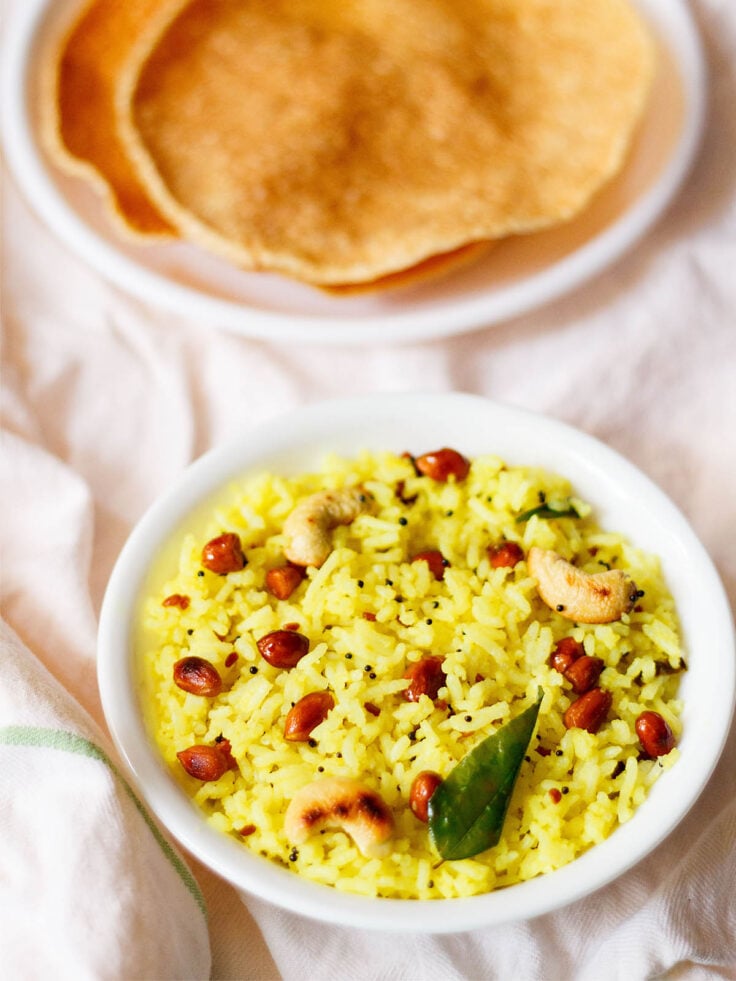
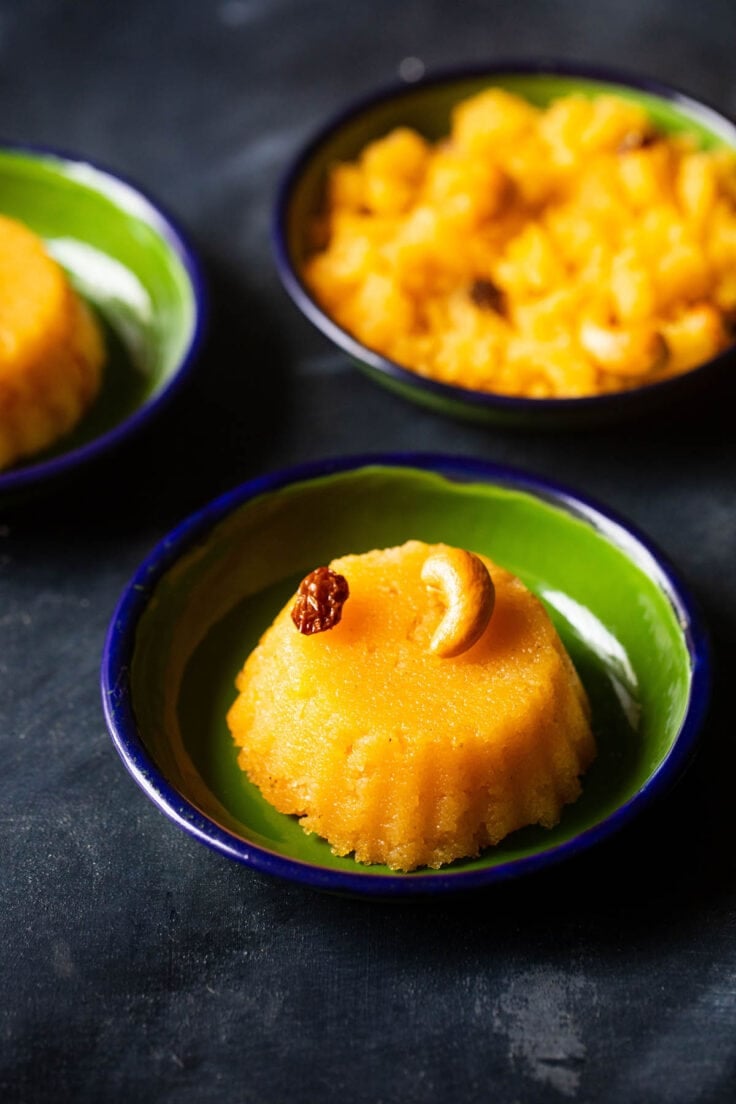
Excellent recipe.
Thank you.
I am from Andhra and your recipe stays true to the authentic flavours. Thank you for sharing.
So glad to hear that, especially from someone from Andhra. It really means a lot. Thank you so much.
Gongura pachhadi is one of the greatest contributions to the world of pickles by the Andhra people.
Absolutely agree! Gongura pachadi is such a flavorful and iconic part of Andhra cuisine. Its bold, tangy taste really does make it one of the finest contributions to the world of pickles.
Thanks for sharing this recipe.
Thanks and welcome Sakshi.
Thanks for sharing the recipe. All your recipes are truly delicious and fail-proof. Will try the pachadi.
Thank you so much Seema. Happy to hear that. Hope you enjoy the pachadi too.